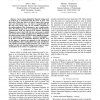Free Online Productivity Tools
i2Speak
i2Symbol
i2OCR
iTex2Img
iWeb2Print
iWeb2Shot
i2Type
iPdf2Split
iPdf2Merge
i2Bopomofo
i2Arabic
i2Style
i2Image
i2PDF
iLatex2Rtf
Sci2ools
ICRA
2008
IEEE
2008
IEEE
Detecting structural ambiguities and transitions during a guided tour
— Service robots designed for domestic settings need to navigate in an environment that they have to share with their users. Thus, they have to be able to report their current state and whereabouts in a way that is comprehensible for the user. Pure metric maps do not usually correspond to the understanding of the environment a user would provide. Thus, the robotic map needs to be integrated with the human representation. With our framework for Human Augmented Mapping we aim to deal with this issue and assume a guided tour as basis for an initial mapping process. During such a tour the robotic system needs to be able to detect significant changes in its environment representation – structural ambiguities – to be able to invoke a clarification discourse with the user. In this paper we present our approach to the detection of such ambiguities, that is independent from prior specification and training of particular spatial categories. We evaluate our method on data sets obtained d...
| Added | 30 May 2010 |
| Updated | 30 May 2010 |
| Type | Conference |
| Year | 2008 |
| Where | ICRA |
| Authors | Elin Anna Topp, Henrik I. Christensen |
Comments (0)

